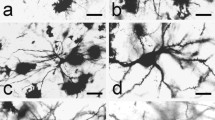Summary
A method is described for the analysis of cell types in mouse dorsal root ganglia using the distribution of cell cross-sectional areas measured at the level of the nucleolus in 1.5 μm Epon sections. Using a computer program it was possible to demonstrate the existence of two normally distributed sub-populations of neurons in all the 3rd lumbar segment ganglia (17 in number) measured at various ages from birth to 70 days. The two populations appeared to correspond with large light cells and small dark cells. The large light cell bodies increased in size until about 20 days postnatal, subsequently their size decreased whereas the mean size of the small dark cells reached a plateau by about day 10. The relationship of both nuclear volume and surface area to the surface area of the perikaryon differed between light and dark cells. The number of neurons in L3 remained virtually constant at about 6000 throughout the period examined. Since the proportion of neurons in each population was not shown to change with age there was no evidence that cells could change from one type into the other.
Similar content being viewed by others
References
Abercrombie, M. (1946) Estimation of nuclear population from microtome section.Anatomical Record 94, 239–47.
Andres, K. H. (1961) Untersuchungen über den Feinbau von Spinalganglien.Zeitschrift für Zellforschung und mikroskopische Anatomie 55, 1–48.
Biscoe, T. J., Lawson, S. N., Makepeace, A. P. W. andStirling, C. A. (1978) Apparatus for the measurement of micrographs and other experimental records.Journal of Physiology (London) 277, 5–6P.
Boutry, J. M. andNovikoff, A. B. (1975) Cytochemical studies on Golgi apparatus, GERL and lysosomes in neurons of dorsal root ganglia in mice.Proceedings of the National Academy of Sciences (U.S.A.) 72, 508–12.
Cammermeyer, J. (1967) Artifactual displacement of neuronal nucleoli in paraffin sections.Journal für Hirnforschung 9, 209–24.
Donaldson, H. H. andNagasaka, G. (1918). On the increase in the diameter of nerve cell bodies and of the fibres arising from them during the later phases of growth (albino rat).Journal of Comparative Neurology 29, 529–52.
Duce, I. R. andKeen, P. (1977) An ultrastructural classification of the neuronal cell bodies of the rat dorsal root ganglion using zinc iodine-osmium impregnation.Cell and Tissue Research 185, 263–77.
Duchen, L. W. andScaravilli, F. (1977) Quantitative and electron microscopic studies of sensory ganglion cells of the Sprawling mutant mouse.Journal of Neurocytology 6, 465–81.
Emery, J. L. andSinghal, R. (1973) Changes associated with growth in the cells of the dorsal root ganglion in children.Developmental Medicine and Child Neurology 15, 460–7.
Gardner, E. (1940) Decrease in human neurones with age.Anatomical Record 77, 529–36.
Hatai, S. (1902) Number and size of the spinal ganglion cells and dorsal root fibres in the white rat at different ages.Journal of Comparative Neurology 12, 107–24.
Harding, J. P. (1949) The use of probability paper for the graphical analysis of polymodal frequency distributions.Journal of the Marine Biological Association of the United Kingdom 28, 140–53.
Hökfelt, T., Elde, R., Johansson, O., Luft, R., Nilsson, G. andArimura, A. (1976) Immunohistochemical evidence for separate populations of somatostatin-containing and substance-P containing primary afferent neurones in the rat.Neuroscience 1, 131–6.
Hughes, A. (1973) The development of dorsal root ganglia and ventral horns in the opposum — A quantitative study.Journal of Embryology and experimental Morphology 30, 359–76.
Kalina, A. andWolman, M. (1970) Correlative histochemical and morphological study in the maturation of sensory ganglion cells in the rat.Histochemie 22, 100–8.
Kawamura, Y. andDyck, P. J. (1978) Evidence for three populations by size in L5 spinal ganglion in man.Journal of Neuropathology and Experimental Neurology 37, 269–72.
Lawson, S. N. andBiscoe, T. J. B. (1979) Development of mouse dorsal root ganglia: an autoradiographic and quantitative study.Journal of Neurocytology 8, 265–74.
Lawson, S. N., Caddy, K. W. T. andBiscoe, T. J. B. (1974) Development of rat dorsal root ganglion neurones. Studies of cell birthdays and changes in mean cell diameter.Cell and Tissue Research 153, 399–413.
Lawson, S. N., May, M. K. andWilliams, T. H. (1977) Prenatal neurogenesis in the septal region of the rat.Brain Research 129, 147–51.
Lieberman, A. R. (1976) Sensory ganglia. InThe Peripheral Nerve (edited byLandon, D. N.) pp. 188–278. London: Chapman and Hall.
Ohta, M., Offord, K. andDyck, P. J. (1974) Morphometric evaluation of the first sacral ganglia of man.Journal of the Neurological Sciences 22, 73–82.
Palay, S. L. andChan-Palay, V. (1974)Cerebellar Cortex, Cytology and Organisation, pp. 322–336. Berlin, Heidelberg, New York: Springer-Verlag.
Parfianowicz, J., Hawrylko, S., Pietrzak, J. andKmiec, B. (1971) Morphology and cytochemistry of the nerve cells of the spinal ganglia.Folia Morphologica (Warszawa) (English Translation)30, 423–31.
Preto Parvis, V. (1954) Distribution of two types of nerve cells with different evolutional characteristics in the spinal ganglia of the cat.Monitore zoologico italiano (Firenze) 63, 352–4.
Sarrat, R. (1970) Zür Chemodifferenzierung des Ruckenmarks und der Spinalganglien der Ratte.Histochemie 24, 202–13.
Scharf, J.-H. andBlumenthal, H.-J. (1967) Neuere Aspecte zur altersabhängigen Involution des Sensiblen Peripheren Nervensystems.Zeitschrift für Zellforschung und mikroscopische Anatomie 78, 280–302.
Scott, S. G. (1912) On successive double staining for histological purposes.Journal of Pathology and Bacteriology 16, 390–8.
Tewari, H. B. andBourne, G. H. (1962) Histochemical evidence of metabolic cycles in spinal ganglion cells of rat.Journal of Histochemistry and Cytochemistry 10, 42–64.
Yamadori, T. (1971) A light and electron microscopic study on the post-natal development of spinal ganglia.Acta anatomica nipponica (Tokyo) 45, 191–205.
Author information
Authors and Affiliations
Rights and permissions
About this article
Cite this article
Lawson, S.N. The postnatal development of large light and small dark neurons in mouse dorsal root ganglia: a statistical analysis of cell numbers and size. J Neurocytol 8, 275–294 (1979). https://doi.org/10.1007/BF01236123
Received:
Revised:
Accepted:
Issue Date:
DOI: https://doi.org/10.1007/BF01236123




